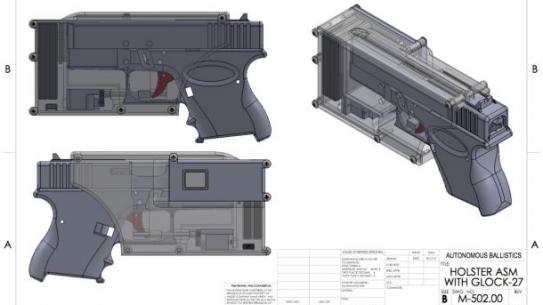NYU Tandon Wins $1 Million Competition for Smart Gun Design

Brooklyn Borough President Eric L. Adams (right) announced the winner of his $1 million Smart Gun Design Competition, awarding the capital grant prize to NYU Tandon on behalf of its team, Autonomous Ballistics. Photo Credit: Erica Sherman/Brooklyn BP’s Office
A student team at the NYU Tandon School of Engineering has won the Smart Gun Design contest funded by Borough President Eric Adams. The $1 million grant was issued to the school to as a capital grant prize on behalf of the team, which was selected by a judging panel to have created the most promising proposal that will prevent unauthorized users from firing a gun.
The team, Autonomous Ballistics, took a divergent approach to nab the million-dollar award, focusing not on a smart gun, per se, but a smart holster, one that allows only the legal owner to draw the weapon. Their innovative design incorporates three different methods to release the gun from the holster. The first uses a fingerprint sensor to match the user’s fingerprints with the owner. The second is an RFID keycard that is worn by the user. Finally, the voice of the legal owner can also be used to authorize and free the gun.
Led by Sy Cohen, an NYU Tandon class of 2017 alumnus with a degree in mechanical engineering, the Autonomous Ballistics team includes Ashwin Raj Kumar, a PhD candidate in the Department of Mechanical and Aerospace Engineering; Jonathan Ng, a class of 2016 alumnus with a degree in mechanical engineering, and Eddilene Paola Cordero Pardo, an officer in the Colombian Navy and a Master’s degree student majoring in technology management. The team is mentored by NYU Tandon Adjunct Professor Anthony Clarke.

“Professor Clarke was my teacher for advanced CAD last year,” recalls Cohen. “When I heard about the competition the summer before the class started I thought it would be a fun project to design a smart gun. I asked him if he would like to be my adviser through this competition.”
He said the team tried and failed at different approaches. “I learned exactly how a gun striker fired semi-automatic pistol worked, and taught my teammates.” He said the team got to work on reverse engineering the trigger mechanism. However, after getting input from gun users, including police officers, they decided to work on an external mechanism. “We focused on developing an attachment and that turned into a holster.”
As a former police officer and a gun owner, Borough President Adams praised the competing teams as contributing positively to the ongoing effort to end gun violence in Brooklyn. “I am so proud of these incredibly innovative young people, who have channeled our collective pain from senseless gun violence into a purposeful mission of designing technology that can save lives,” he said.
“The Smart Gun Design Competition is a testament in so many ways to faith in the future — on the part of Borough President Adams and all of Brooklyn that the enthusiasm of students and the expertise of faculty can help curb gun violence, on the part of students and faculty across the borough that they can make significant contributions to their community, and on the part of the City and civic organizations that technology can play a meaningful role in solving this national problem,” said Kurt H. Becker, vice dean for research, innovation, and entrepreneurship at NYU Tandon. “We congratulate the four students of Autonomous Ballistics, along with their faculty advisor Anthony Clarke, for their early achievements in Borough President Adams’ groundbreaking challenge, and we pledge to continue supporting their efforts to embody our school’s mission to create technology that will serve the good of society.”
The other finalists were Energy Environmental Simulation (EES) Lab from New York City College of Technology, Intelligent Defense Systems (IDS) from Pratt Institute, Pew Pew from New York City College of Technology, and Smartfire Technology from NYU Tandon. They were all awarded $10,000 from Adams' discretionary budget toward their research.




